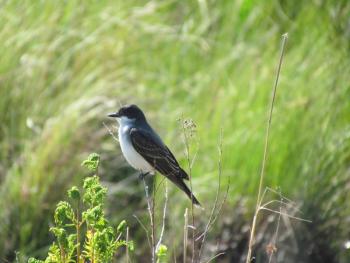Our new dog has come through for us again. We decided to take our little black chug (pug-chihuahua cross) to a dog social club—otherwise known as a dog park—to make some friends and cavort like any dog should. We have found that the dog park in Augusta at Mill Park, alongside the Kennebec River, to be terrific. It’s got lots of running room for the doggies, with a gate to close off the small dog section from the big dog one (ours falls just shy of a medium-sized dog, but he fancies himself one of the big boys). There are doggy wading pools with a hose for fresh water. Benches invite the humans to relax and chat with other dog-loving people while the doggies mingle.
It’s also a cool place to bird.
We remember when that site was home to a massive and rather decrepit old textile mill. We have known people who worked long and hard in that mill when it was running. When we first started birding near the mill, the Edwards Dam spanned the river, and it was difficult to find a place to get enough access to see the river.
An important date in the history of returning the river to health occurred on July 1, 1999, when that 917-foot-wide dam was removed to allow the river to run free, the fish to migrate up and down the river, and plants, aquatic insects, and other invertebrates—and birds—to repopulate parts of the river that they had not been part of for more than a hundred years.
On this bright, sunny July day when we brought our little canine, Loki, to the Mill Park dog park, the scene was very different from the place it had been decades ago. Our little doggy found a whole host of friendly dogs of all shapes, sizes, and ages to run around with inside the roomy fenced in area. We loved seeing how much fun he was clearly having, and we enjoyed comparing experiences with the other dog lovers.
While Loki ran about with his new friend Potato (a jindo mix), we enjoyed the view of a beautiful, free-flowing river. A pair of mockingbirds sang from the hedges in the park, imitating a dozen or more other species of birds including a great rendition of an osprey and a cardinal. Several eastern kingbirds zoomed about on their rapidly beating wings, chattering noisily and showing off the white tip to their black tail as they erupted into the air. Several American goldfinches flew up from the green shrubbery along the river bank looking like golden jewels.
And then we heard it: The rough “brrrt” call rarely heard anywhere but near a river or lake. It was the sound of a northern rough-winged swallow. Listening closely, we could hear more. Down below, over the riverbank, we could see at least a half-dozen.
The northern rough-winged swallow is not a flashy-looking bird. It’s brown on top and white underneath with a dusky throat. The closest look-alikes are the bank swallows, which also are brown on top and white underneath but are smaller and have a single brown band across the breast. They sound different, too—more buzzy. Immature tree swallows are also brownish above and white below but they lack the dusky throat.
Rough-wings are one of the most uncommon of Maine’s breeding swallow species. They expanded their range north into the state beginning in the 1940s, slowly extending northward. Today, they still occupy only a third or less of the state, in the southern portion. Maine is at their northeastern range limit.
Rough-winged swallows prefer to nest mostly along rivers and sometimes lakes. They nest in holes— either natural holes as in old kingfisher burrows or, more commonly nowadays, in holes in bridges and walls overlooking the water. Their smaller look-alikes, the bank swallows, build nests in dirt or packed sand banks; typically, they nest in what are often large colonies. Rough-winged swallows, by contrast, rarely seem to occur in numbers more than ten at a single location. Here in Maine at least, there is often only a pair or two at any single site. And there are not many places you can even find them here.
We were certainly very pleased to discover these rough-wings thanks to our dog park adventure. Loki and his new doggy friends were happy, too.
Jeffrey V. Wells, Ph.D., is a Fellow of the Cornell Lab of Ornithology and Vice President of Boreal Conservation for National Audubon. Dr. Wells is one of the nation's leading bird experts and conservation biologists and author of the “Birder’s Conservation Handbook.” His grandfather, the late John Chase, was a columnist for the Boothbay Register for many years. Allison Childs Wells, formerly of the Cornell Lab of Ornithology, is a senior director at the Natural Resources Council of Maine, a nonprofit membership organization working statewide to protect the nature of Maine. Both are widely published natural history writers and are the authors of the popular books, “Maine’s Favorite Birds” (Tilbury House) and “Birds of Aruba, Bonaire, and Curaçao: A Site and Field Guide,” (Cornell University Press).


-Wenzel.jpg)



























